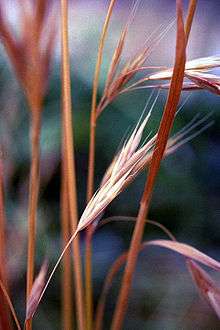Bromus carinatus
| Bromus carinatus | |
|---|---|
 | |
| Scientific classification | |
| Kingdom: | Plantae |
| (unranked): | Angiosperms |
| (unranked): | Monocots |
| (unranked): | Commelinids |
| Order: | Poales |
| Family: | Poaceae |
| Genus: | Bromus |
| Species: | B. carinatus |
| Binomial name | |
| Bromus carinatus Hook. & Arn. | |
| Synonyms | |
|
Bromus breviaristatus | |
Bromus carinatus is a species of brome grass known by the common names California brome and mountain brome.
It is native to western North America from Alaska to northern Mexico, where it can be found in many types of habitat. It is known in parts of the American midwest and eastern North America as an introduced species.
Description
Bromus carinatus is a perennial bunchgrass growing in clumps 0.5 to 1.5 meters tall, with many narrow leaves up to 40 centimeters long. The inflorescence is a spreading or drooping array of flat spikelets longer than they are wide.
The grass is wind-pollinated but is also sometimes cleistogamous, so that the flowers pollinate themselves, especially under stressful conditions. It also reproduces vegetatively via tillers.
This species is highly variable. It can be easily confused with B. catharticus and B. stamineus.
Uses
This grass is used for control of erosion and revegetation of damaged land, as well as a highly palatable forage for livestock; however, it has the capacity to become a noxious weed in agricultural settings.[1]
References
External links
- Jepson Manual Treatment - Bromus carinatus
- USDA Plants Profile
- Forest Service Fire Ecology
- Bromus carinatus - Photo gallery